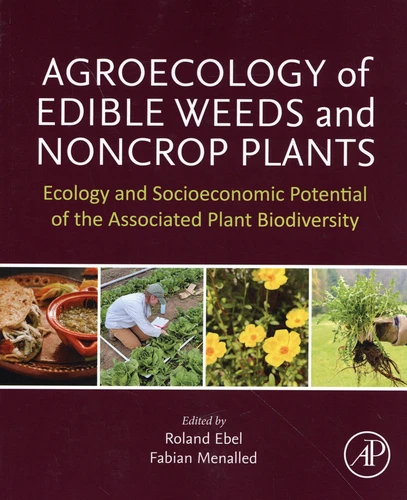Agroecology of Edible Weeds and Non-Crop Plants. Ecology and Socioeconomic Potential of the Associated Plant Biodiversity
Par : ,Formats :
- Paiement en ligne :
- Livraison à domicile ou en point Mondial Relay indisponible
- Retrait Click and Collect en magasin gratuit
- Nombre de pages295
- PrésentationBroché
- FormatGrand Format
- Poids0.695 kg
- Dimensions19,0 cm × 23,5 cm × 1,5 cm
- ISBN978-0-443-16076-9
- EAN9780443160769
- Date de parution24/09/2024
- ÉditeurAcademic Press
Résumé
"Agroecology of Edible Weeds and NonCrop Plants : Ecology and Socioeconomic Potential of the Associated Plant Biodiversity" is the first book to discuss underutilized edible noncrops or edible weeds from an agroecological perspective and explore management approaches to optimize their ecological and socioeconomic potential. With case studies of edible weeds and noncrop plants from around the world and across a wide range of agroecosystems, this book highlights the diverse opportunities offered by these plants.
Those interested in using edible noncrop plants to diversify the farming landscape and food systems have access to a plethora of information on the ethnobotany of these species, yet little to no information exists on the agroecological requirements and benefits of underutilized edible noncrops. Set in the context of sustainable farming systems, this book fills this knowledge gap by examining edible weeds and noncrop plants from an agroecological perspective.
It reviews current information and knowledge gaps on the ecological importance of edible weeds as members of the associated biodiversity of traditional and industrialized cropping systems, evaluates the ecological mechanisms responsible for their presence and abundance in different agroecosystems, assesses the socioeconomic and nutritional potential of these species across societies, and pinpoints areas of future transdisciplinary research that will spearhead the use of edible noncrops in the 21st-century food systems, aiming for the persistence of diverse agroecosystems and foods.
This book includes much-needed information for managing, and benefitting from underutilized plant species. This book is ideal for agricultural professionals, educators, researchers, and students.
Those interested in using edible noncrop plants to diversify the farming landscape and food systems have access to a plethora of information on the ethnobotany of these species, yet little to no information exists on the agroecological requirements and benefits of underutilized edible noncrops. Set in the context of sustainable farming systems, this book fills this knowledge gap by examining edible weeds and noncrop plants from an agroecological perspective.
It reviews current information and knowledge gaps on the ecological importance of edible weeds as members of the associated biodiversity of traditional and industrialized cropping systems, evaluates the ecological mechanisms responsible for their presence and abundance in different agroecosystems, assesses the socioeconomic and nutritional potential of these species across societies, and pinpoints areas of future transdisciplinary research that will spearhead the use of edible noncrops in the 21st-century food systems, aiming for the persistence of diverse agroecosystems and foods.
This book includes much-needed information for managing, and benefitting from underutilized plant species. This book is ideal for agricultural professionals, educators, researchers, and students.
"Agroecology of Edible Weeds and NonCrop Plants : Ecology and Socioeconomic Potential of the Associated Plant Biodiversity" is the first book to discuss underutilized edible noncrops or edible weeds from an agroecological perspective and explore management approaches to optimize their ecological and socioeconomic potential. With case studies of edible weeds and noncrop plants from around the world and across a wide range of agroecosystems, this book highlights the diverse opportunities offered by these plants.
Those interested in using edible noncrop plants to diversify the farming landscape and food systems have access to a plethora of information on the ethnobotany of these species, yet little to no information exists on the agroecological requirements and benefits of underutilized edible noncrops. Set in the context of sustainable farming systems, this book fills this knowledge gap by examining edible weeds and noncrop plants from an agroecological perspective.
It reviews current information and knowledge gaps on the ecological importance of edible weeds as members of the associated biodiversity of traditional and industrialized cropping systems, evaluates the ecological mechanisms responsible for their presence and abundance in different agroecosystems, assesses the socioeconomic and nutritional potential of these species across societies, and pinpoints areas of future transdisciplinary research that will spearhead the use of edible noncrops in the 21st-century food systems, aiming for the persistence of diverse agroecosystems and foods.
This book includes much-needed information for managing, and benefitting from underutilized plant species. This book is ideal for agricultural professionals, educators, researchers, and students.
Those interested in using edible noncrop plants to diversify the farming landscape and food systems have access to a plethora of information on the ethnobotany of these species, yet little to no information exists on the agroecological requirements and benefits of underutilized edible noncrops. Set in the context of sustainable farming systems, this book fills this knowledge gap by examining edible weeds and noncrop plants from an agroecological perspective.
It reviews current information and knowledge gaps on the ecological importance of edible weeds as members of the associated biodiversity of traditional and industrialized cropping systems, evaluates the ecological mechanisms responsible for their presence and abundance in different agroecosystems, assesses the socioeconomic and nutritional potential of these species across societies, and pinpoints areas of future transdisciplinary research that will spearhead the use of edible noncrops in the 21st-century food systems, aiming for the persistence of diverse agroecosystems and foods.
This book includes much-needed information for managing, and benefitting from underutilized plant species. This book is ideal for agricultural professionals, educators, researchers, and students.


